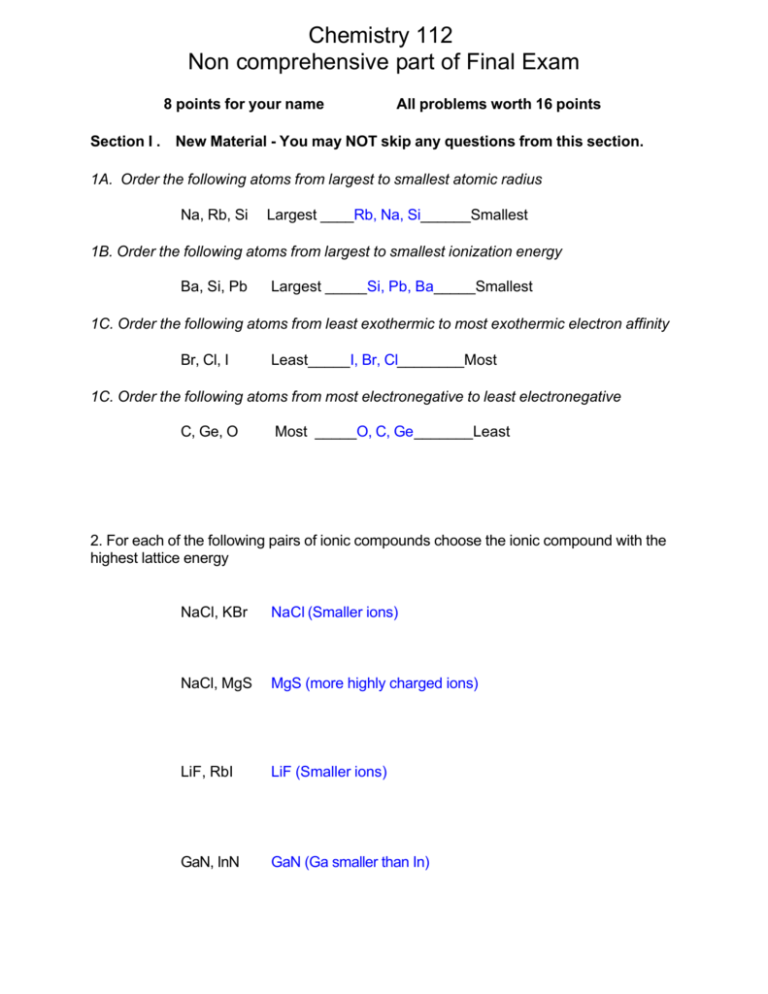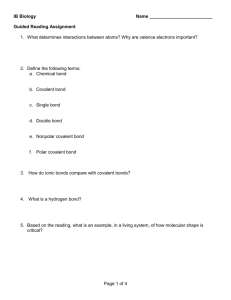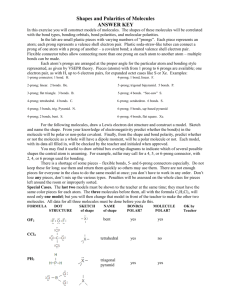Test 4
advertisement

Chemistry 112 Non comprehensive part of Final Exam 8 points for your name All problems worth 16 points Section I . New Material - You may NOT skip any questions from this section. 1A. Order the following atoms from largest to smallest atomic radius Na, Rb, Si Largest ____Rb, Na, Si______Smallest 1B. Order the following atoms from largest to smallest ionization energy Ba, Si, Pb Largest _____Si, Pb, Ba_____Smallest 1C. Order the following atoms from least exothermic to most exothermic electron affinity Br, Cl, I Least_____I, Br, Cl________Most 1C. Order the following atoms from most electronegative to least electronegative C, Ge, O Most _____O, C, Ge_______Least 2. For each of the following pairs of ionic compounds choose the ionic compound with the highest lattice energy NaCl, KBr NaCl (Smaller ions) NaCl, MgS MgS (more highly charged ions) LiF, RbI LiF (Smaller ions) GaN, InN GaN (Ga smaller than In) 2 3. Below are several reactions we have seen in this term. Write a chemical equation for each reaction: First Ionization Energy X(g) 6X+(g) + e Second Ionization Energy X+(g) 6 X2+(g) + e Electron affinity X(g) + e -6 X-(g) Lattice Energy X(g) + Y(g) 6XY(s) Sublimation X(s)6X(g) Bond Energy X2(g)62X(g) Reduction X(aq) + e -6 X-(aq) Oxidation X(aq) 6X+(aq) + e - 4. Ammonia (NH3) may be synthesized in the following reaction: N2(g) + 3H2(g) 6 2NH3(g) (reaction by bonds: N/N + 3 H-H 66 N-H) Determine the )Hrxn using the following bond energy table Bond Energy (kJ/mol) H-H 432 H=H 850 N-H 391 N=H 800 N-N 160 N=N 418 N/N 941 Note: This table contains some fake bonds to make the problem more interesting. You may have to make some Lewis structures to figure out which bonds you actually need to use. Reactant bonds - product bonds (941 + 3(432))- 6(391) = 2237-2346 = -109 kJ/mol 3 5. For each of the following compounds give a. A Lewis Structure b. The electron arrangement around the central atom c. The molecular arrangement around the central atom d. Bond angles e. Are the bonds in the molecule polar or non-polar f. Is the molecule polar or non-polar A. NF 3 B. XeO4 5+21 = 26 electron 8+24 or 13 pairs = 32 electr on or 16 pairs b. Tetrahedral c. Trigonal pyramid b. Tetrahedral c. Tetrahedral d. <109 d. 10 9 e. e. Bonds polar Bonds polar f. Molecule Polar Molecule nonpolar C. OCl2 6+14 = 20 electrons or 10 pairs b. tetrahedral c. V-shaped d. <109 e. Polar bond f. Polar molecule f. D. SF5+ 6 + 35 -1 = 40 electrons b. trigonal bipyramid c. trigonal bipyramid d. 120 & 90 e. Polar bonds f. Nonpolar molecule 4 6. A. Nitrous oxide (N2O) has three possible Lewis structures, find these three structures (In these structures N is the central atom) B. Using Formal charge decide which is the best structure Left Center Right N Left 5-6=-1 5-5=0 5-7= -2 5-4=+1 5-4=+1 5-4=+1 N Center O right 6-6=0 6-7=-1 6-5=+1 Best 1 atom 0 Formal charge O has a - formal charge C. Given the following bond lengths, predict the bond lengths you should observe in this compound: N-N 167 pm, N=N 120 pm, N/N 110 pm, N-O 147 pm, N=O 115 pm, N/O 105pm N/N should be 110 pm - actual is 112 so is just about right N-O should be 147 pm - actual is 119 so is much shorter ( more like a double bond) than predicted








